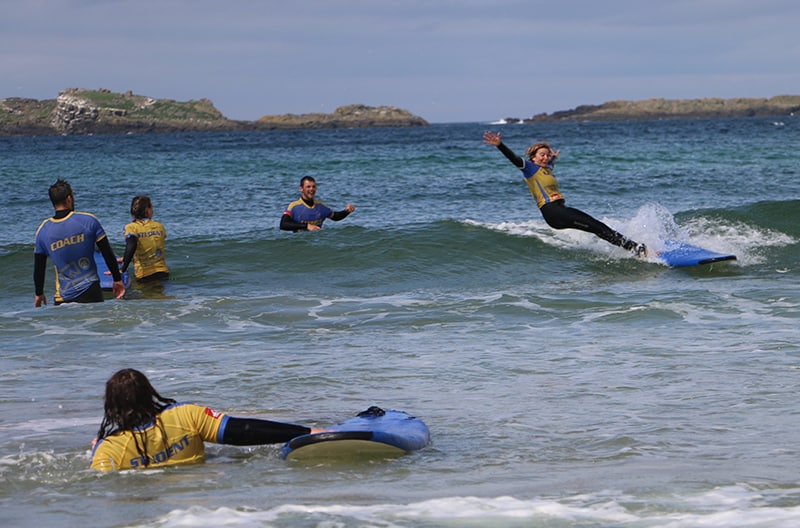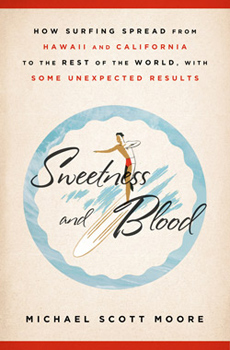
Sweetness and Blood: The Story of Surfing
By Helena Wahlstrom
What do Germany, Morocco, the United Kingdom, Israel, Cuba, and Japan have in common? Few will readily guess that each of these countries is featured in an extraordinary book about surfing.
Sweetness and Blood by Michael Scott Moore surprises readers not only with its unexpected take on surfing history. Moore’s superb skill as a writer allows readers to experience the sweetness and blood of both surfing and life as he sees them.
In 1907, George Freeth brought surfing over to the U.S., to Moore’s hometown of Redondo Beach, California, to be exact. Moore grew up knowing that fact, but it wasn’t until much later, after he had spent time in Germany and heard of a small group of hardcore German surfers, that he began to wonder who Freeth, also a German, really was.
“There had to be someone, either mythical or real,” Moore says on radiofreemike.com — his website, which is now dead. From that question came Sweetness and Blood, and it is everything you’d expect a travel book about surfing not to be like. On his journeys tracing the history of surfing from California and Hawaii to the most unexpected places, Moore depicts his travels with vibrant detail and incredible depth.
Even if you don’t care a lick about surfing, this book is worth reading for its captivating stories and beautiful writing alone. Far from a pleasure-seeking surfer-dude trip, Moore’s book neglects neither side of the coin.

“When a surfer takes off on a wave, there are two possible results, and my book is about them both.”
An excerpt from the book Sweetness and Blood
Cuba: La Otra Revolución
In a beachside neighborhood, I flagged down a powder blue Cadillac with fins.
“¿A Habana Vieja?”
“Sí, sí.”
No room in the back, so I sat in front. The dashboard had cheap wooden panels and backlighting provided by old pale bulbs. A Cadillac eagle logo rendered in steel reached its wings over my knees.
Most of Havana’s máquinas, or gypsy cabs, are old American iron. They’re run by Cubans for other Cubans, and visitors aren’t supposed to ride them. But there was almost no way to move in Cuba without breaking the law.
“American?” the driver said when the car was almost empty.
“Yes.”
“What brought you to Cuba?”
I should mention that some máquinas have rotten energy and can’t be romanticized — a driver in one was so drunk he gave me a five-peso rebate. Another driver was either on morphine or believed his car would collapse if he leaned on the gas.
He crawled through the night with his friend riding shotgun, both of them clean-cut, muscular, and intolerably slow. His friend talked above the roar of the motor in rapid molten Spanish, but the driver kept saying, “¿Hay?”
But cruising Havana in a good máquina put me in a rare fine mood. You rumbled along a boulevard where crumbling ruins of colonial Spain alternated with a Communist cinderblock. The seductive, gorgeous, fading tropical light was tainted green by tree ferns and African baobabs. The leaden stink of exhaust leaked through the windows and floors, and the car trembled in places new cars don’t even have.
“But Cuba has no waves,” my driver said.
“Cuba has a surf club. Una asociacíon de surfistas.”
“Where?”
“In Miramar.”

Miramar was a grid of trees and broken sidewalks west of central Havana where hotels and embassies stood along the water. We were driving from there past the Malecón, Havana’s great seawall.
The ocean slammed against the wall with spectacular plumes that could have made the driver think twice about his judgment of Cuban surf…
Miramar has palm-lined sidewalks and chain-linked yards, mansions along the main boulevard, and a smattering of schools with white plaster busts of José Martí, the poet and martyr of the war of independence in the 1890s.
I stayed in a casa particular, an apartment in a small family home. My hostess was a generous madwoman named Marta. She had youthful braids in her gray-frosted hair, hazel eyes, and a taste for brown-printed blouses with nothing on underneath. She lived in the furnished rooms next door with her quiet teenage daughter and her ancient mother.
My clean kitchen contained a fridge, a table, and nothing else. No oven, no hot plate, no electric kettle, nada. Cubans called their refrigerators cocos, because they’re hard-shelled and empty. I had a sparkling new white coco.
Marta called me “¡Mígue!” and kept finding reasons to knock on my door.
“Do you need a table for the sitting room?” she said.
There was a bare but sun-bright front room with two comfortable chairs.
“I don’t think so.”
“You should keep the door closed,” she said. “Open the window if you like the sunlight.”
“Oh? Is that better?”
“You need anything else?”
“I’d like to rent a bike,” I said. “And make a phone call.”
She said something in galloping Spanish that I took for an invitation to come around and use the phone when I was ready. Fine. It wasn’t urgent. But after an hour she returned with a telephone and a workman who fed an extension line through my window. This generosity with items from her side of the house continued until I had an electric cooking coil, a frying pan, and a small pot for boiling water. Soon I felt like a king!
“¡Mígue!”
“Sí, Marta.”
“How many days do you want to rent the bicicleta?”
“Just for a couple of days.”
It would prove difficult — actually impossible — to rent a bicycle in Cuba. During the Special Period, the island had swarmed with ten-speeds from China, but now the economy had revived and people rode buses again.
“Be sure to close this window whenever you go out,” she went on, “because someone could reach in and open the door.”
“Okay, Marta.”
“And I need to clean in here. Want me to do it today or tomorrow?”
She did not need to clean. I’d been in Cuba for three days. But when I returned from surf the next morning she was scrubbing the shower and washing the floor. She’d also rearranged my kitchen items to her satisfaction.
The dish drainer and hot plate had been left in the wrong positions on the counter by the clueless American bachelor, and even a carton of mango pulp, which I kept in the fridge, had been moved to the counter. Mango pulp was good on crackers, and I’d learned how hard it could be to spread when refrigerated. But I was trying to keep away flies.
Regal Simplicity
The feeling of regal simplicity of Marta’s casa would wear off in less than a week. My hot plate began to malfunction. Whenever the coil turned red a surge protector on the power strip would snap off, so it was impossible to boil water without sitting over the power strip to snap it back on every two or three seconds.
When the water had boiled, the remaining heat would fry a strip of bacon, then eggs in the grease, if you tended now and then to the switch. But you needed the power strip — the wall sockets were dirty and required a grounded plug — and the dream of preparing instant coffee while taking a shower (for example) vanished over the horizon of first-world privilege…
A Santeria Follower
A Santeria follower stood on the limestone at Seventy with a maraca. He had a black plastic doll with him, wrapped in blue velvet; someone explained to me later that such dolls represent the souls of certain ancestors.
Devotees keep these dolls in their homes, dressed in hand-sewn clothes, but sometimes they have to be cast away almost like an exorcism. The man with the maraca left his doll behind, along with a couple of gutted watermelons.
Other surfers arrived, one by one, on foot or by moped. One surfer had a brother with a beautiful old turquoise Chevrolet, which they’d used for atmosphere in some scenes for a Spanish documentary about Cuban surfing called Havana Surf.
But most of them were too poor to own cars. “If we had cars, we could explore,” Eduárdo said. The documentary director had sent a handful of surfers on a road trip across Cuba, and for the first time they went to Baracoa, an Atlantic-facing bay in the far east with excellent waves. “I had no idea my country was so beautiful,” Eduárdo said.
BUY THIS BOOK: Sweetness and Blood: How Surfing Spread from Hawaii and California to the Rest of the World, with Some Unexpected Results
- Japan: Touring the Temple - March 4, 2014
- Best Budget Carry-on Luggage for Travel: Top 6 - June 17, 2012
- Many Ways to See Rome: Walking, Biking, Vespa, Bus and Boat - June 1, 2012

